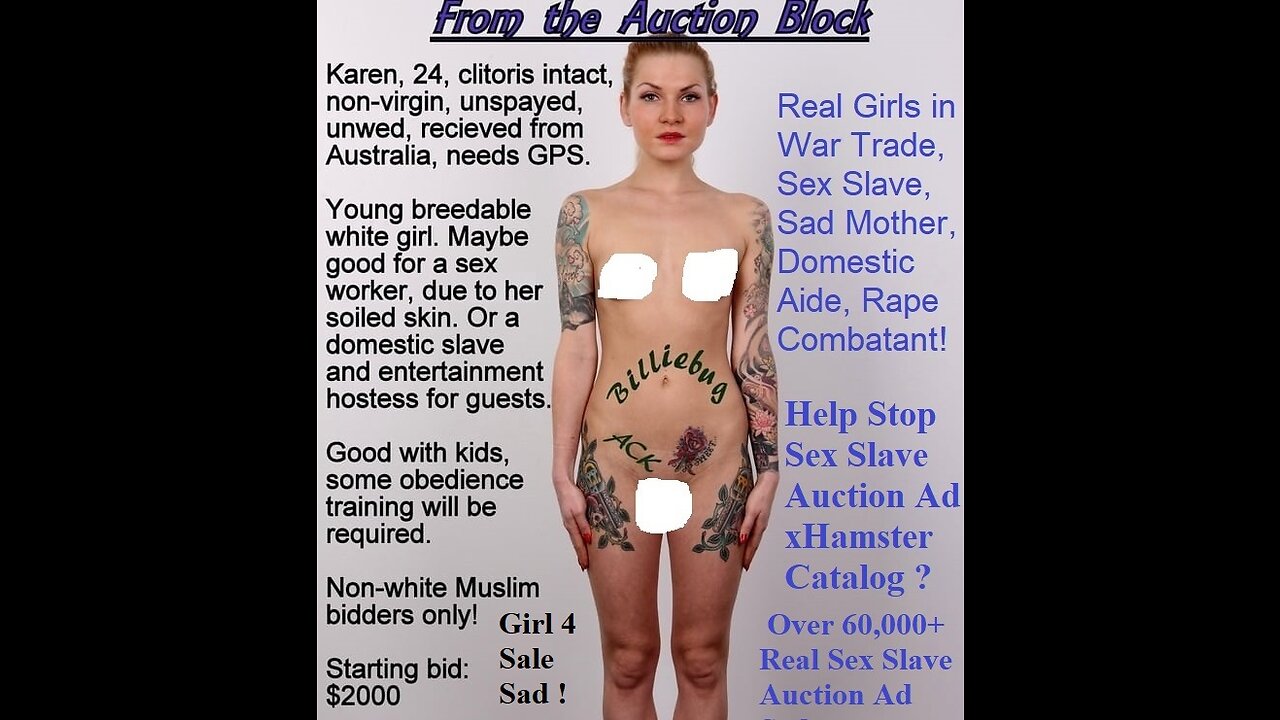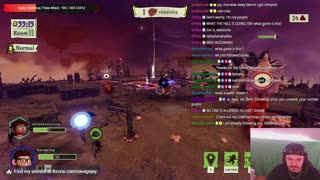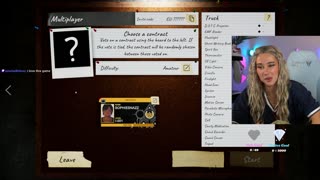Premium Only Content

Terror Slavery Chronicles & Other Woman Escapes Sexual Slavery Auction ** GRAPHIC **
So Terror Slavery Groups ISIS and U.S.A. and Others Wide World Groups Now Has Sex Slave Rape and Death Guidelines and Slavery Chronicles and There is maps of underground sex-slave bars in the American. Always fascinated by the concept of human slavery and how it worked. (So far I've have seen over 60,000+ ISIS or Muslim and Others auction-block sex slave ad) How was it own a human and see him/her as just a property. How was it to be owned, right-less by law, being bought and sold side by side to other animals. How was it to be part of a community where, by pure luck mostly, you might own every thing and live as a king without any effort, or you might own nothing even yourself So Here I Imagine a world where slavery became legal again. I write some times as a master/mistress, sometimes as a slave and some times as just an observer. I will even share some posts of interest, and write some true historical excerpts about slavery. Excuse my English, I am not a native speaker P.S. It is pure fantasy Just when you thought ISIS couldn’t get any worse, they have now put out guidelines for how to rape your sex slaves. "Islamic State theologians have issued an extremely detailed ruling on when "owners" of women enslaved by the extremist group can have sex with them, in an apparent bid to curb what they called violations in the treatment of captured females.
The ruling or fatwa has the force of law and appears to go beyond the Islamic State's previous known utterances on slavery, a leading Islamic State scholar said. It sheds new light on how the group is trying to reinterpret centuries-old teachings to justify the rape of women in the swaths of Syria and Iraq it controls.
Just when you thought ISIS couldn’t get any worse, they have now put out guidelines for how to rape your sex slaves. Probably not the best PR move… Cenk Uygur, host of the The Young Turks, breaks it down. Tell us what you think in the comment section below.
“Islamic State theologians have issued an extremely detailed ruling on when “owners” of women enslaved by the extremist group can have sex with them, in an apparent bid to curb what they called violations in the treatment of captured females.
The ruling or fatwa has the force of law and appears to go beyond the Islamic State’s previous known utterances on slavery, a leading Islamic State scholar said. It sheds new light on how the group is trying to reinterpret centuries-old teachings to justify the rape of women in the swaths of Syria and Iraq it controls.”*
Exclusive - Islamic State ruling aims to settle who can have sex with female slaves. Islamic State theologians have issued an extremely detailed ruling on when “owners” of women enslaved by the extremist group can have sex with them, in an apparent bid to curb what they called violations in the treatment of captured females. The ruling or fatwa has the force of law and appears to go beyond the Islamic State’s previous known utterances on slavery, a leading Islamic State scholar said. It sheds new light on how the group is trying to reinterpret centuries-old teachings to justify the rape of women in the swaths of Syria and Iraq it controls. The fatwa was among a huge trove of documents captured by U.S. Special Operations Forces during a raid targeting a top Islamic State official in Syria in May. Reuters has reviewed the document, which has not been previously published, but couldn’t independently confirm its authenticity.
Among the fatwa’s injunctions are bans on a father and son having sex with the same female slave; and the owner of a mother and daughter having sex with both. Joint owners of a female captive are similarly enjoined from intercourse because she is viewed as “part of a joint ownership.”
The United Nations and human rights groups have accused the Islamic State of the systematic abduction and rape of thousands of women and girls as young as 12, especially members of the Yazidi minority in northern Iraq. Many have been given to fighters as a reward or sold as sex slaves.
Sex trafficking in the United States is a form of human trafficking which involves reproductive slavery or commercial sexual exploitation as it occurs in the United States. Sex trafficking includes the transportation of persons by means of coercion, deception and/or force into exploitative and slavery-like conditions. It is commonly associated with organized crime.
It has been estimated that two-third of trafficking victims in the United States are US citizens. Most victims who are foreign-born come into the US legally, on various visas. State Department estimated that between 65,000 and 450,000 women and girls are trafficked each year into the United States.
Far from trying to conceal the practice, Islamic State has boasted about it and established a department of “war spoils” to manage slavery. Reuters reported on the existence of the department on Monday.
In an April report, Human Rights Watch interviewed 20 female escapees who recounted how Islamic State fighters separated young women and girls from men and boys and older women. They were moved “in an organised and methodical fashion to various places in Iraq and Syria.” They were then sold or given as gifts and repeatedly raped or subjected to sexual violence.
Girls in War Sex Slave, Mother, Domestic Aide, Combatant he attackers tied me up and raped me because I was fighting. About five of them did the same thing to me until one of the commanders who knew my father came and stopped them, but also took me to his house to make me his wife. I just accepted him because of fear and didn't want to say no because he might do the same thing to me too." This is the testimony of a young girl of 14 from Liberia as told to the Machel Review in a focus group conducted jointly by the United Nations Children's Fund (UNICEF) and the Office of the Special Representative of the Secretary-General for Children and Armed Conflict (OSRSG/CAAC).
This story shows how vulnerable girls are in armed conflict. Actually, they can be affected by war in five different ways. Firstly, they are often direct victims of violence -- killed, maimed or sexually violated as war crimes are committed against them. Secondly, they can be recruited and used as combatants for fighting in the battlefield. Thirdly, as refugees and internally displaced persons (IDPs), they remain in insecure environments, often deprived of basic amenities. Fourthly, they are frequently trafficked and exploited, as perpetrators abuse their vulnerability. Finally, when they become orphans, some of them have to manage child-headed households, eking out a living for themselves and their siblings.
Direct violence - The number of children who are victims of direct violence, especially killings, has greatly increased in the last few years. Many have lost their lives in the confrontation between terrorism and counter terrorism. We have seen the phenomenon of children being used as suicide bombers and we have seen children as victims of aerial bombardment, a part of what is euphemistically called "collateral damage".
In Afghanistan I met Aisha, a girl whose home had been destroyed during an air raid which killed many of her family members, and whose school had been attacked by insurgents opposing education for girls. But Aisha was determined to go on with her studies so that she could become a school teacher.
Sexual violence - Girls are often raped or violated in situations of conflict. Raping girls and women is often a military strategy aimed at terrorizing the population and humiliating the community. At other times, the climate of impunity in war zones leads to rape and exploitation by individual soldiers who know they will not be punished. Eva was a young girl I met in the Democratic Republic of the Congo. She and her friend were walking to school when they were waylaid by armed members of the Democratic Liberation Forces of Rwanda. They were taken to the camp, repeatedly raped, compelled to live in a state of forced nudity and assigned to domestic chores for the members of the group. Eva finally escaped and found shelter in Panzi hospital, a refuge for victims of sexual violence, where she found out that she was pregnant. She was 13 years old. When I met her, Panzi hospital was taking care of her child while she was attending school. They were trying to trace her family, even though they knew that girls who are victims of rape are often shunned by their next of kin.
Girl soldiers - Increasingly, girls are being recruited into fighting forces as child soldiers. Some are abducted and have to play the dual role of sex slave and child combatant. This was particularly true in the wars of Sierra Leone and Liberia. In other cases, girls join the fighting forces for a multitude of reasons because they identify with the ideology, they want to run away from home or they have no other option for survival. Maria was a former girl child soldier whom I met in Colombia. She joined the rebel groups because her brothers had joined before her. Subjected to domestic violence at home, she ran away. She fought with the rebels and was then captured during one of the confrontations. Today she feels very lost. She does not want to go back home and she feels she has neither the education nor the skills to survive alone. When I met her, she was being taken care of by a foster parent. She felt boys were frightened of her because of her past. She also told me that many girls who had left the movement finally end up in sex work as a survival strategy.
Internally displaced - Eighty per cent of the world's refugees and internally displaced are women and children. Displaced children are perhaps one of the most vulnerable categories. In many parts of the world they are separated from their families while fleeing, becoming orphans overnight. And living in camps, they are often recruited into the fighting forces. Displaced children also suffer from high rates of malnutrition and have little access to medical services. Many girls are victims of violence in the camp or when they leave the camp to gather firewood and other necessities. For those who advocate for the rights of displaced children, the first priority should be security. The objective is to ensure that children are safe, protected from sexual violence and recruitment, and that there are child-friendly spaces in the camp. The second priority is education. Recently, UN agencies and non-governmental organizations (NGOs) have partnered to advocate strongly that education is an integral part of emergency response and not a luxury development. This was one of the key messages of the General Assembly debate on Education in Emergencies, in March 2009. It is important to plan for schools and play areas for children as the camp is constructed and provisions are made for families to be settled. It gives children a sense of normalcy and routine when they live in the camps.
Trafficking and sexual exploitation - Another concern we have for girl children in situations of armed conflict is that they are often trafficked and sexually exploited. At the international level, commentators have always pointed to "waves" of trafficking: that is, particular groups being trafficked in large numbers at a particular time. These waves often occur in areas of armed conflicts; women flee in large numbers, and being sex workers is their only survival strategy. They become victims of terrible exploitation by ruthless international criminal gangs. So many of these stories have been chronicled and a great deal of effort has been made over the last two decades to tackle the phenomenon. Nevertheless, the ground realities of conflict still lead to the sexual vulnerability of girls and women. Our own peacekeepers have not been immune to these situations. The UN Department of Peacekeeping Operations has made it a priority through their zero tolerance policy and code of conduct and discipline to ensure that this type of activity ceases and that peacekeepers will only be seen as protectors.
Orphans and child-headed households - The terrible toll of war also makes many children into orphans overnight. In many parts of the world, we are seeing child-headed households where children have to fend for themselves as well as for older children. This happens especially to girl children who have to take over the role of parents. Parentless children often live in deplorable conditions such as broken-down buildings with leaky roofs, or no roofs at all. They sleep together under torn plastic sacks and cook with old rusty cans and broken pottery. They are susceptible to all manner of diseases and their situation is terribly vulnerable and heartbreaking. UN agencies are trying ways of giving these children a future without institutionalizing them in centres. It is their aim to keep children in the community and make it the responsibility of the community to take care of its children. Through schemes that find foster homes and foster mothers, they hope to let the children enjoy the benefit of family life.
The international tribunals and the fight against impunity - How has the international community responded to these devastating descriptions of what girl children suffer during war time? Recently things are slowly beginning to change, especially in the fight against impunity. The first breakthrough for children was the establishment of international tribunals which began to hold perpetrators accountable for international crimes. The cases before the tribunals of the Former Yugoslavia and Rwanda that dealt with sexual violence, created a framework of international jurisprudence that will help us in the future. Individual women found justice, and there is always the deterrent effect that cannot be measured in an empirical manner. Recently, the Special Court for Sierra Leone found several commanders of the Revolutionary United Front guilty of 16 charges of war crimes and crimes against humanity including conscription and enlistment of children under 15 into the fighting forces. The setting up of the International Criminal Court was the culmination of this trajectory. Their first case, the Thomas Lubanga case, involved the recruitment and use of children as child soldiers, strengthening the cause for children. Our office submitted an amicus curiae to the court in that case, arguing that girl children should be brought into the ambit of protection. We advocate for the young, abducted girls who play multiple roles in camps, to receive the protection of the law against being recruited, used, as well as forced to participate in the hostilities. We hope to get our day in court to argue this point of view so that the enormous suffering of girl children does not remain invisible.
Involvement of the Security Council - In the area of children in armed conflict, another mechanism that has begun to chip away at impunity is Security Council resolution 1612. The resolution, passed in 2005, created a Working Group on Children and Armed Conflict. It also established a monitoring and reporting mechanism involving a Task Force at the national level made up of all the UN agencies, assigned to report on the violations. The Task Force is chaired by either the Resident Co-coordinator or the Special Representative and is often co-chaired by UNICEF. Through this mechanism, OSRSG/CAAC receives bimonthly reports on grave violations against children in war zones. The Security Council process is informed by the Annual Report of the Secretary-General to the Council which lists parties that recruit and use child soldiers. Resolution 1612 recommends the prospect of targeted measures against persistent violators of children's rights. The hope in 2009 is to extend these measures, beyond the recruitment and use of child soldiers, to include sexual violence against children, such that those who persistently use sexual violence in war be listed, shamed and face the possibility of sanctions. Having received the full support of the UN system, it is hoped that Member States, especially those in the Security Council, will help our office deliver on this promise.
In a world where there is so much abuse against women and children, one may become cynical about these small steps that the international community has begun to take to fight impunity, but we must not underestimate their effects. Recently, I was in the Central African Republic and met three generations of women in one family who had been raped when Jean-Pierre Bemba's troops attacked the capital, Bangui. They were getting ready to go to The Hague to testify against him. Their elation at the possibility of justice, and their gratitude that these things have come to pass has convinced me that we are on the right path. Grave violations, war crimes and crimes against humanity must be taken seriously, so that the culture of impunity that often hangs over warfare be broken.
Reintegration of former child soldiers - Another area where the international community can help is the field of rehabilitation and reintegration. Reintegrating children affected by war is a major task facing Governments, UN agencies and NGO partners working in the field. The Paris Principles give us a framework on how to reintegrate children associated with armed groups, but these principles are also a guide to reintegrating all children. The call for community-based programming that works with the child, while developing the family and the community in an inclusive manner, must be the starting point for child-based programming. And yet, some children need special attention. Research shows that children who were forced to commit terrible crimes and children who were victims of sexual violence need special care and attention. Girl children often have different needs from boys. Treating children as important individuals while, at the same time, developing the community in a holistic manner, is the only sustainable way forward.
Finally we cannot even begin to speak of the psychological toll that war takes on children. When I was in Gaza, I went to a school and entered a classroom of nine year-old girls, who were drawing in an art class. I moved from one to the other, and then I just looked down at one girl's drawing, Ameena's. She had drawn a house and she explained to me that the two figures in the house were her mother and herself. Above the house there was a mangled object which I gather was a helicopter gunship; to the left of the house there was an imposing looking tank and to the right of the house, a soldier. All these were firing at the home. Her sad, dull eyes on her beautiful face told the rest of the story. Meeting the day to day reality of war is a terrible calling for all of my colleagues working in the field. But rebuilding the shattered lives of children is an even more daunting task; to make them smile again, care again and live with purpose is the challenge of the hour.
An undercover investigation for National Geographic explored the prevalence of sex trafficking within the United States, where the business of sexual slavery is booming.
When some people hear about sex trafficking in America they usually think of Asian and Eastern European women being brought into the States, but it's actually 10 times more likely for an American girl to be trafficked inside the U.S. Further, almost 300,000 American children are at risk for trafficking into the sex industry, according to U.S. Department of State statistics.
For National Geographic's "Inside: Secret America" series, investigative journalist Mariana van Zeller, who is now a correspondent for Fusion, an ABC News joint venture with Univision, and her producers Darren Foster and Alex Simmons went undercover on the streets of Houston to get a first-hand glimpse inside the world of sex trafficking. The "American Sex Slave" episode aired on Wednesday at 10 p.m. on the National Geographic Channel.
During the investigation, a man who had been in the lobby of a massage parlor at a strip mall waved van Zeller over to his car. The man told her he was a lawyer and the spa was known around town as a place where men can pay $200 to get the "full service." He then offered van Zeller money and said if she "took care" of him, then he would "take care" of her.
"This guy told me that if I worked five guys a day that I could make $1,000 a day, and it was pretty good," van Zeller told her team after she walked away. When van Zeller looked up the man later that evening, she said she found he does have a professional job and did not find evidence he was a pimp.
However, during the course of her investigation, van Zeller learned about the wide range of pimps. She sat down with sex trafficking victim Jillian Mourning. Growing up as the quintessential girl-next-door, Mourning was a high school cheerleader and a straight-A student. As a 19-year-old college freshman, she said she became a part-time model.
But while on one job in Scottsdale, Ariz., Mourning told van Zeller that three men entered her hotel room in the middle of the night. One of them was a man in the modeling industry. "And they all raped me, and they videotaped it and photographed it," Mourning said. When she returned home to Charlotte, N.C., Mourning told van Zeller that she was too embarrassed to tell her friends what had happened to her and too afraid to go to the police. She decided to put the incident behind her, but then she said her abuser called.
"He wanted me to meet these men and sleep with them, and he gets all the footage," Mourning said. "And I was like, 'I'm not comfortable with that." and then he said, "well, you know, in other words, if I'm not going to be able to get you to do this voluntarily, then you're still going to do it.'"
Mourning told van Zeller that her abuser claimed he had the videos of her being raped in Arizona and he threatened to sell them on the Internet with her name attached to them if she didn't prostitute for him.
"It became threat after threat after blackmail after blackmail," Mourning said. "So when he went to say, 'hey, you know, I need you to go to this city,' or 'I'm in Charlotte and I need you to meet with this person,' then I did." Mourning said her trafficker was a wealthy and respected member of the Charlotte community, not someone who would have been suspected of sex trafficking.
"Every single person that walks the face of the Earth has an aspect of vulnerability," Mourning said. "We all have something that can make us vulnerable. Traffickers and pimps and anybody that is in that industry knows how to find that weak spot." Jessica Ford, another young woman who is a sex trafficking survivor, told van Zeller that she was trafficked for years by pimps at massage parlors all over the country.
"Thinking back, it makes me sick how many different people got in all the different places in my body," she said. Ford said she was one of hundreds of victims in her ring and that the that the youngest girl she saw being trafficked was 13 years old, but passed as older.
"We had girls in Las Vegas. We had girls here in Houston, Texas. We had girls in Oklahoma. I mean, there was girls just coming in from all over the place." She also told van Zeller that while she was being trafficked, she was "branded" with a very large panther tattoo with the name "Big Jon" on her back.
"I was just a piece of property, that's why we got branded," she said. "I have a panther on my back. That was their little logo. Majority of us girls had a panther tattooed on us with their names or name… you can't cover it."
In 2009, the FBI indicted the gang of pimps responsible for trafficking Ford, and in 2013, three of the traffickers were sentenced to eight years in prison. "They should have gotten the death penalty," Ford said. Thousands of times every day, young American women are bought and sold. Mark Blackwell and Amiee Johnson, local activists in Charlotte, work the streets regularly to try to rescue girls from being trafficked.
"They may not change their lives right away, they may go back to the streets, they may give up," Johnson said. "But they had an opportunity there that someone loved them unconditionally, and they'll realize that someone is always waiting for them to come home."
-
 14:22
14:22
What If Everything You Were Taught Was A Lie?
5 days agoThe Day Americans Were Robbed Of 3,600+Tons Of Gold & Confiscation Executive Order 6102
1.49K3 -
 2:58:09
2:58:09
SavageJayGatsby
5 hours agoSpicy Saturday with Mally! - Wedding in 2 Months!
35.2K1 -
 1:47:14
1:47:14
VapinGamers
7 hours ago $2.05 earnedTools of the Trade - Does Production Matter? with Tim the Tool Man from Louder with Crowder
26.3K2 -
 LIVE
LIVE
BSparksGaming
5 hours agoHappy Saturday! Battlefield 6 Beta! PS5 Gameplay
74 watching -
 15:53
15:53
Exploring With Nug
14 hours ago $3.92 earnedExploring Texas Creeks for Fossils – Prehistoric Treasures Everywhere!
32.9K4 -
 9:02
9:02
MattMorseTV
11 hours ago $15.50 earnedTrump's FBI just DECLASSIFIED the UNEDENIABLE PROOF.
40.5K91 -
 3:57:54
3:57:54
TinyPandaface
4 hours agoYour FACE is A Gaming Channel! | Mario Golf Super Rush w/ The Fellas!
6.37K2 -
 2:50:10
2:50:10
sophiesnazz
8 hours ago $4.12 earned6kd in these ghost lobbies !socials !specs
27.9K2 -
 25:39
25:39
MYLUNCHBREAK CHANNEL PAGE
1 day agoThey Already Had A.I.
53.9K44 -
 4:02:38
4:02:38
GamerGril
10 hours agoI'm Not Lost, I'm Just Wandering Until I Know Where I am | The Evil Within
30.7K3